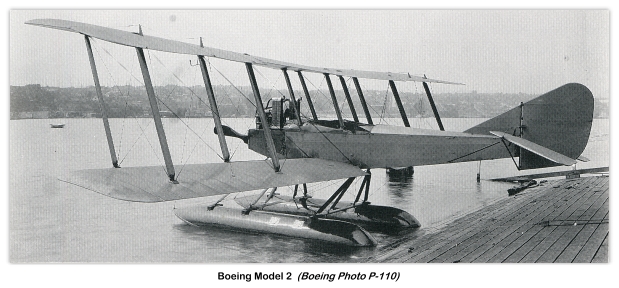
| ||||
|---|---|---|---|---|
 |
 |
 |
 |
 |



























| ||||
|---|---|---|---|---|
 |
 |
 |
 |
 |


























Boeing Model 2
USN Biplane Seaplane Trainer

Overview 1,2
The Boeing Model 2 (C-4) was so named because it was the third airplane design used and the fourth aeroplane owned by Boeing, including the Martin seaplane. It was the second Boeing design, even though the firm was still known as Pacific Aero Products at the time it was built, and carried Serial Number 3 because it was the third airplane built. It was an entirely original design and differed considerably from the B&W both in basic aerodynamic characteristics and general appearance. The wings had an unusual degree of stagger and dihedral angle compared to other aircraft of the period for the purpose of providing inherent stability. This was considered by the Boeing engineers as the most desirable characteristics for a training aeroplane. The tail services differed from the B&W and that the horizontal stabilizer was deleted and the vertical fin added. The C-4 was dismantled after testing but was rebuilt and flown in August 1918. See Model 3 for specifications. 2
Design and Development 1
Pacific Aero-Products, the forerunner of the Boeing Company, built its first all-original airplane, the "Model C" naval trainer. Early design work was started in late 1915, with the first wind tunnel tests being conducted at MIT’s 4 ft wind tunnel in May 1916. Much of the design work was performed by James Foley, who had previously assisted George Conrad Westervelt in designing the Boeing Model 1. Westervelt, who had been reassigned to the East Coast in December 1915, consulted heavily on the design. Wong Tsu, a MIT graduate who was hired by Boeing in May, 1916, also contributed to the design, specifically lending his expertise in analysis of wind tunnel data. A total of 56 Boeing "C-type" trainers were built; 55 used twin pontoons. The Model C-1F had a single main pontoon and small auxiliary floats under each wing and was powered by a Curtiss OX-5 engine.
Operational History 1
The success of the Model C led to Boeing’s first military contract in April 1917 and prompted both its reincorporation as the Boeing Airplane Company and relocation from Lake Union, Washington to a former shipyard on the Duwamish River, also in Washington. The United States Navy bought 51 of the Model C trainers, including the Model C-1F, and the United States Army bought two landplane versions with side-by-side seating, designated the EA.
The final Model C was built for William Boeing and was called the C-700 (the last Navy plane had been Navy serial number 699). On March 3, 1919 Boeing and Eddie Hubbard flew the C-700 on the first international mail delivery, carrying 60 letters from Vancouver, British Columbia, Canada, to Seattle, Washington.
Variants 1
Operators 1
Boeing Model 3 Specifications 1
General Characteristics
Performance
References